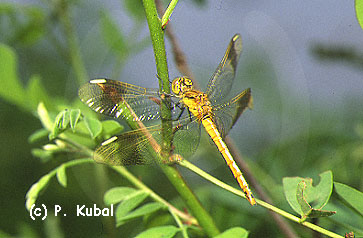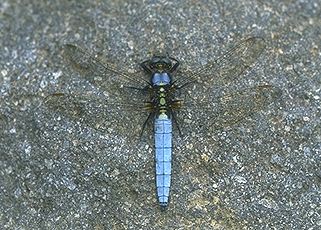|
HOME |
|
|
HOME |
|
Some of the most interesting creatures of the pond are dragonflies and their young, called nymphs. Both the adult dragonfly and its nymph eat large quantities of mosquitoes. catching them while it is flying. There are many different species of dragonflies. Some dragonfly species live for several years. The earliest dragonflies appeared over 300 million years ago.

Dragonflies are excellent fliers, and can fly at speeds of over 30 km per hour. They can even fly backwards and hover like a helicopter! They have large compound eyes. Each eye contains over 30 000 facets. Dragonflies do nearly everything in the air. They hunt, mate, feed, and lay eggs in flight. The eggs develop in the water of the pond or stream. The newly hatched young are known as nymphs.
LIFE CYCLE
A dragonfly larva hatches from an egg which is laid in water or in plants near water or even underwater. This aquatic (living in the water) larva grows tremendously. It moults (loses its old skin) many times. When fully-grown, it emerges from the water, using the claws on its feet to crawl onto a plant. The dragonfly flies away over land. It only returns to the water to reproduce and continue this cycle.

Depending on the kind of dragonfly, the nymph can spend from a few months to a few years developing into the adult stage. They must undergo a number of moults as they grow. The exoskeleton splits down the middle of the back allowing a new larger version of the nymph to develop. During the final moult a stubby-winged adult emerges. It climbs above the surface of the water onto the stem of plants, and pumps blood into its limp wings. After resting and drying in the sun, the exoskeleton and wings stiffen. The adult then takes flight.
The dragonfly nymph has a specially adapted mouth that can capture a wide variety of foods such as fish, tadpoles, and mosquito larvae. Its special mouth piece is called a labium. It is a long, hinged structure that shoots out, pierces the prey with two pincers, and pulls the prey in for a meal. Scientists are amazed at the speed at which this special mouth piece can capture prey. It is estimated to take only two-tenths of a second to make the capture and return the prey to its mouth.
The nymph breathes by drawing water through its anus into gills located inside its abdomen. The gills remove the oxygen from the water and then the water is squirted out through the anus. Some live in the submerged vegetation, often attaching themselves to the stems of plants. Some crawl along the bottom of the pond in search of food.